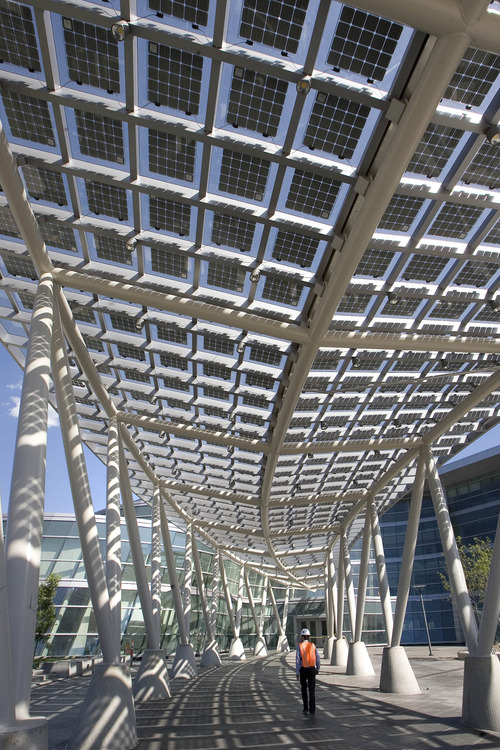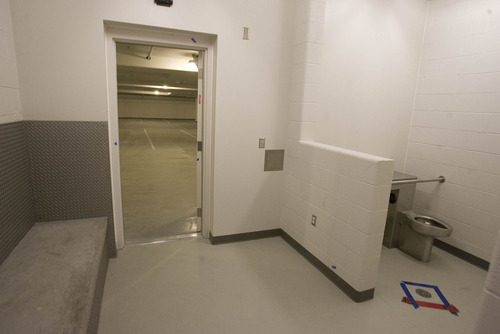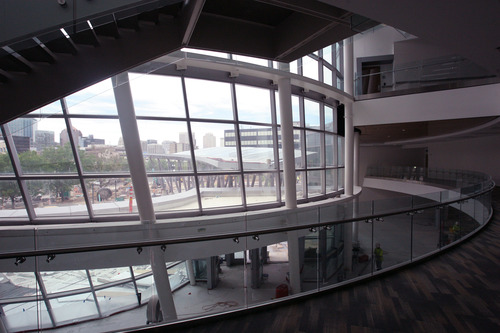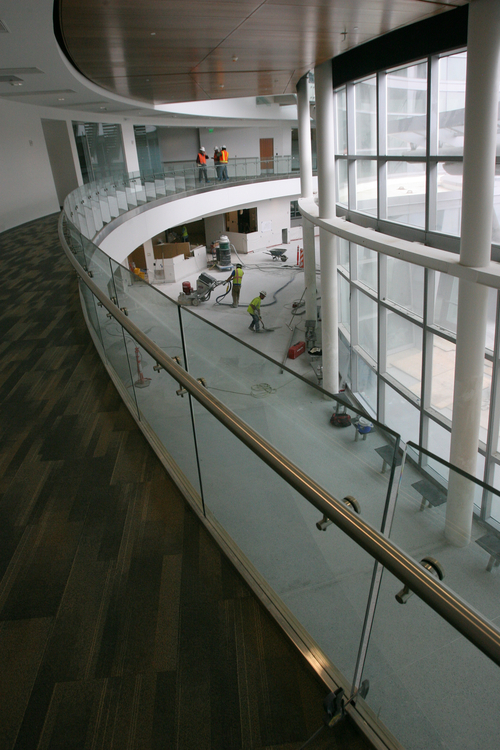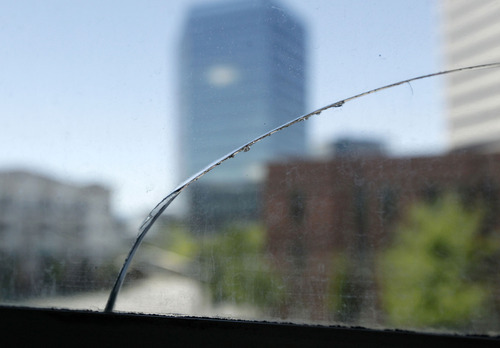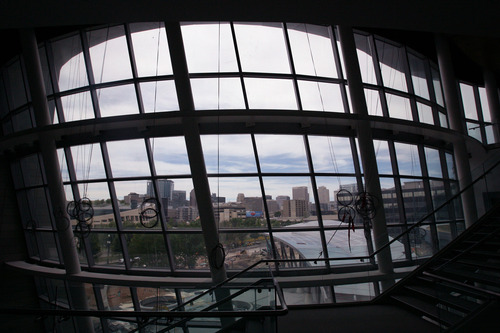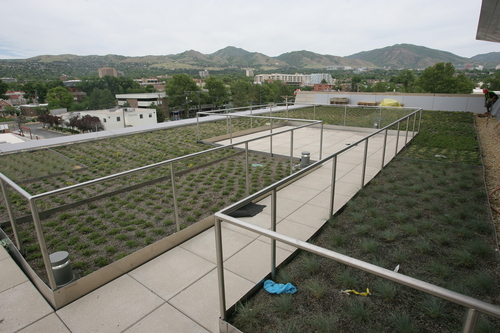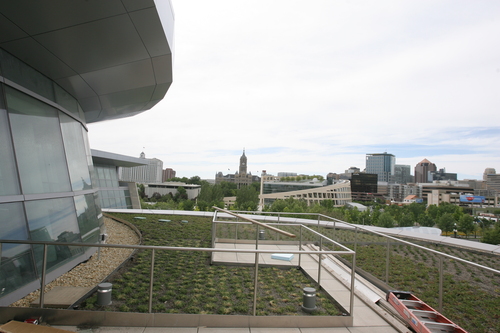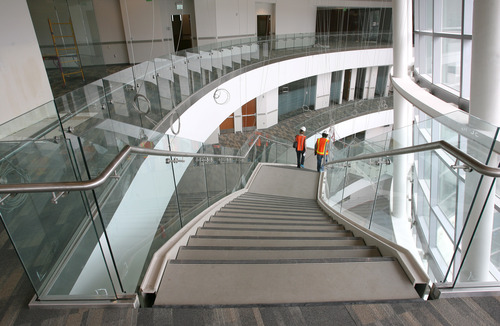This is an archived article that was published on sltrib.com in 2013, and information in the article may be outdated. It is provided only for personal research purposes and may not be reprinted.
Kurt Cook is no weatherman, but he's always known which way the wind was blowing — from inside his office.
Turns out, the clear tape that employees slapped over a large crack in the Salt Lake City fire chief's window couldn't block south winds from whipping through his office in the city's dilapidated Public Safety Building.
"It's like poking at a scab," Cook said of the tape. "Next thing you know, there's a hole in it again."
But come August, that broken window will be just a wind-swept memory as Cook and hundreds of other city employees move into their new home — the state-of-the-art Public Safety Building paid through a taxpayer-approved bond.
The new PSB is full of light, energy-efficient features, working elevators — and unbroken windows. Later this month, the public will be invited to tour the facility.
"I am really excited to share [this] with the public and show what we've accomplished together," said Salt Lake City Police Chief Chris Burbank. "I'm very pleased with how it's all come together. Most important to me is the public support because that has made the difference and enabled us to accomplish this."
—
Form and function • The 175,480-square-foot PSB will house about 276 police employees, 69 emergency dispatchers, 38 fire employees and four workers with the emergency management division.
It stands as a stark contrast to the existing dark, dank and creaky structure at 315 E. 200 South, which suffers from overcrowding, occasional fires, stuck elevators, raw sewage spills and water floods deep enough to fill elevator shafts. Space is at such a premium that multiple people are squashed into cubicles. Closets have been turned into offices. In an effort to save on energy, every other light bulb has been removed in places, creating checkerboard lighting.
Emergency Management Director Cory Lyman likens the condition of the building to the 1973 film "Serpico," in which Al Pacino's character spends his days working in "dingy" conditions.
But there's nothing dingy about the new $125 million structure.
"It's a stunning building," said Kevin Miller, president of GSBS Architects, which was tapped to design the facility. "It's really simple. It's really straightforward. There's nothing about it that doesn't do something for us. There's not an element of the design that doesn't accomplish at least a few goals that were put before us."
Among those goals was a building that functioned well for all the people who will use it.
Suspects will no longer come face to face with witnesses and victims who are working with police. Sex offenders who are required to register with police will have their own entrance. Internal Affairs is set off to provide privacy.
Detectives from various divisions will share space so they can better collaborate on cases, particularly those involving criminals suspected of committing multiple crimes across the city.
Cook said residents who need building inspections, plans reviewed, permits and special-event coordination from the Fire Department will have room to lay out everything in that new office area, allowing for much better public engagement.
"The space is really well designed for collaborative working," Lyman said. "It's designed around a very easy work flow."
All of it will happen in a building designed to withstand terrorist attacks and magnitude 7.5 earthquakes.
Early on, city leaders had clear aspirations for the PSB, said Miller. In addition to function, the city wanted an energy-efficient structure that would blend into the downtown campus that includes Library Square — and the showcase Main Library — The Leonardo museum and historic City Hall. They also wanted an open plaza — displaying public art — capable of staging new and existing city events (such as the Utah Arts Festival) and a permanent public safety museum in the lobby.
"They wanted it to stand up to the library and City Hall," Miller said. "They wanted it to be an open and inviting public safety building, which is kind of an unusual stance for public safety. The entire north elevation is glass. It invites people to have a look at what's going on."
That openness is just what Burbank desired.
"This will be the most open public safety building that I have ever visited," he said. "We want people to come visit the Police Department. It is a neat place to see, and there will be a lot of exciting things happening in the lobby and the plaza."
—
Going green • But what likely will place the PSB in a class all its own is its net-zero capability, which means it will generate as much energy as it uses.
"[This] sets an example for what can be done with our buildings," Salt Lake City Mayor Ralph Becker said. "We have the first net-zero Public Safety Building in the country, and it's getting a lot of national and even international attention."
It's believed to be the largest net-zero building in the country, according to Miller.
"Salt Lake City is really progressive in that regard," he said. "They went out on a big limb. This isn't a building that lends itself to that very well [at first glance]."
The PSB is filled with natural light. The north side is mainly glass because it's not exposed to direct sunlight. The other sides are protected from direct sun exposure.
The entry canopy has 3,000 square feet of solar panels, and there are an additional 22,000 square feet of panels in the main roof. Still more solar panels will be located off-site.
Roofs covered with plants will reduce the amount of water that enters the storm-drain system and help cool the building.
To save energy, motion sensors will shut off power if a room isn't in use. Radiant floors and chill-beam systems, which circulate water through pipes to cool the building with minimal duct work, will efficiently control the building's climate.
Former Salt Lake City Council member Deeda Seed, who served on the architect-selection committee, said the facility was definitely needed. She has not yet been inside the building but said its outward appearance "represents function over form."
"I don't think it's the prettiest building I've ever seen, honestly," she said. "It's a really big, muscular building. But it's a public safety building, so what do you expect?"
—
Blessing follows backlash • Like most projects of its size, the PSB came with a measure of controversy.
After residents voted down the original $192 million bond package, the project was scaled back. But when the city announced it wanted to place the PSB on Library Square, residents rebelled.
John Becker (no relation to the mayor) was an outspoken opponent of that plan and said he and the mayor exchanged "hard words."
"They responded to the people's strong feelings," John Becker said. "They had quite a few hearings and workshops. They responded by finding a new location. I didn't care where it went as long as it wasn't on the [Library Square] block."
Ultimately, the city agreed to shift the project east, across the street from Library Square. More than 60 percent of voters then gave the new PSB bond a thumbs-up.
"There were people who thought the building was going to be a fortress and would create a terrible dynamic in the community because they thought of a public safety building as being a fortress that separates the city," Mayor Becker said. "There were people who thought the building would be so imposing that it would destroy the aesthetics of downtown."
While the mayor said those concerns were legitimate, he believes the city was responsive, even though there may still be "some wounds in the community over the decisions we were making."
John Becker said he recently toured the new building and was impressed — at least from an architectural perspective.
"I looked at it more as a architectural project than as a public safety building because I don't know what's going on there," he said. "It could have just been an ugly block of cement, I think. Thankfully that didn't happen. It is a handsome building and a nice addition to the city."
Even the Utah Taxpayers Association ultimately backed the project. Royce Van Tassell, association vice president, said the group monitored plans to help cut costs, including saving $2 million on less expensive windows.
"Certainly the Public Safety Building needed to be replaced," Van Tassell said. "It appears they have a building that will last long into the future and meet the public safety needs and that of the city and much of the county. I think the taxpayers will really be well-served."
jstecklein@sltrib.comTwitter @sltribjanelle —
Tour the new Public Safety Building
A public ribbon-cutting ceremony is July 19 at noon, although the building won't open for business until later this year (no date has been set). Until then, both departments can be contacted at the current Public Safety Building, 315 E. 200 South.
Here's how to tour the new building:
Where • 475 S. 300 East, Salt Lake City.
July 20 • 10 a.m. to 6 p.m.
July 22, 23, 25 • 10 a.m. to 4 p.m.
July 26 • Noon to 8 p.m.
July 27 • 10 a.m. to 6 p.m.
Groups • Call Natalie at 801-537-0900 or email natalie@exoro.com to set up a tour. —
By the numbers
$125,000,000 • Total cost
175,480 • Square feet of functional space
372 • Below-ground parking spots for police and fire.
77 • LED illuminated tiles that create a large video wall
75 • Perimeter, in feet, as a blast protection area
52 • Dampers to help earthquake-proof the building
30 • Motorcycle parking spots for law enforcement vehicles
24 • Amount, in inches, the floor in the room that holds computer equipment can move side-to-side
7.5 • Magnitude quake the building can withstand and be completely operational
2 • Free community rooms for public use. They can be combined into one large room or split into two rooms.
1 • Fitness center open to any city employee who works in the city's civic campus and passes a background check
0 • Net amount of energy building will use





